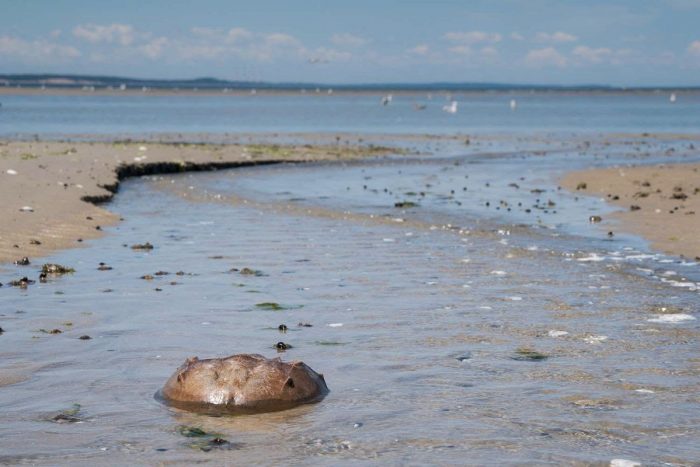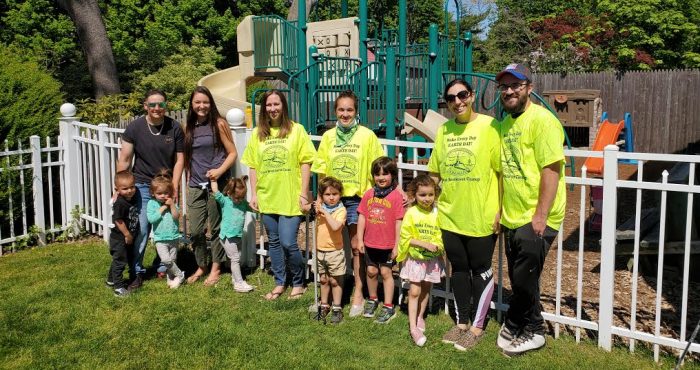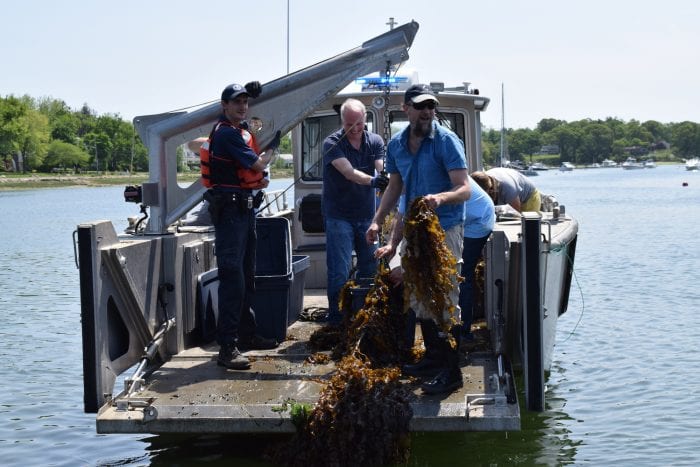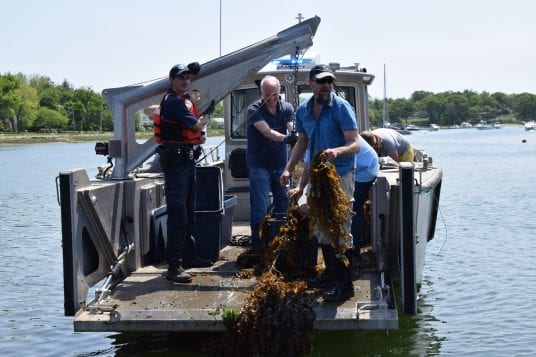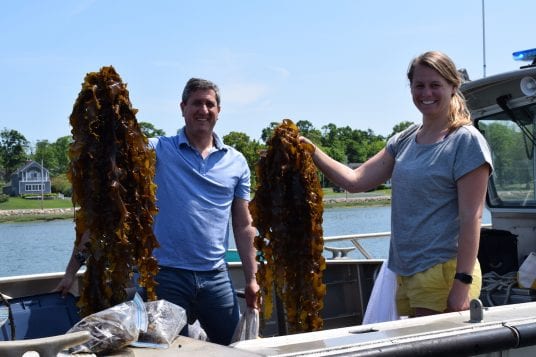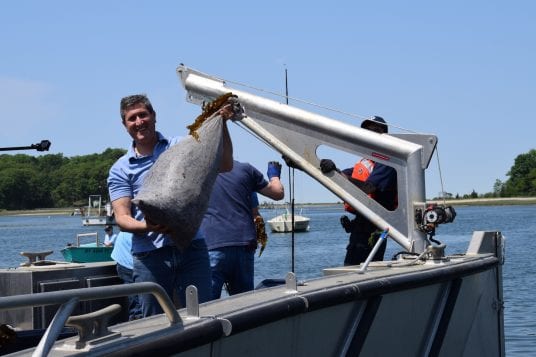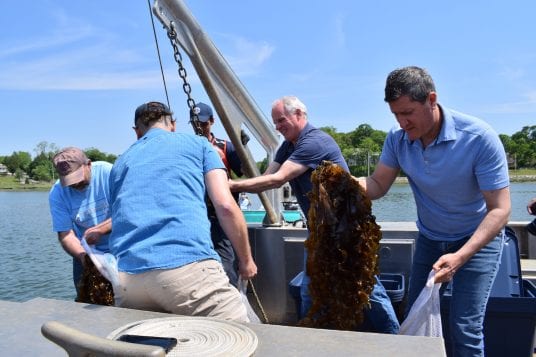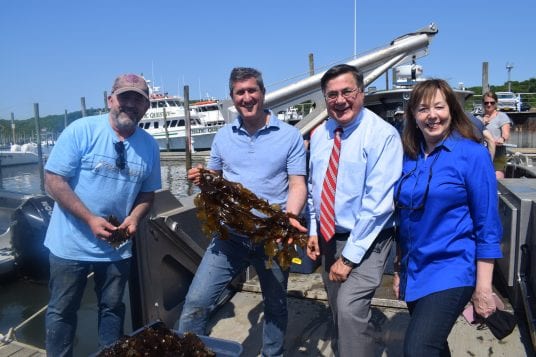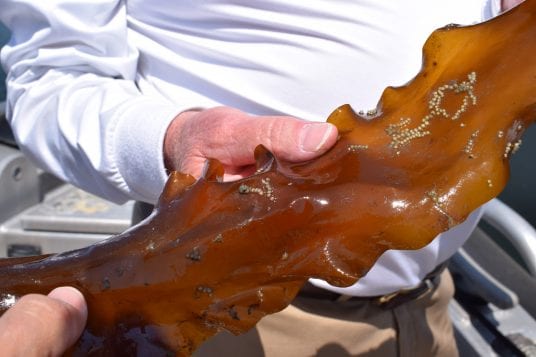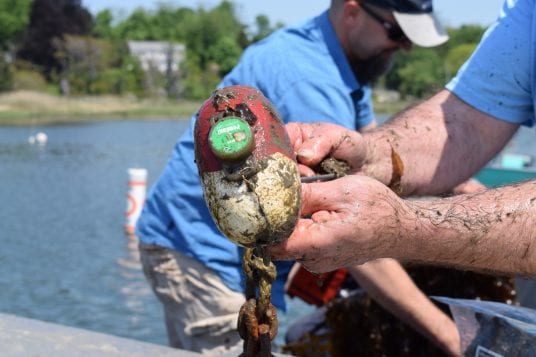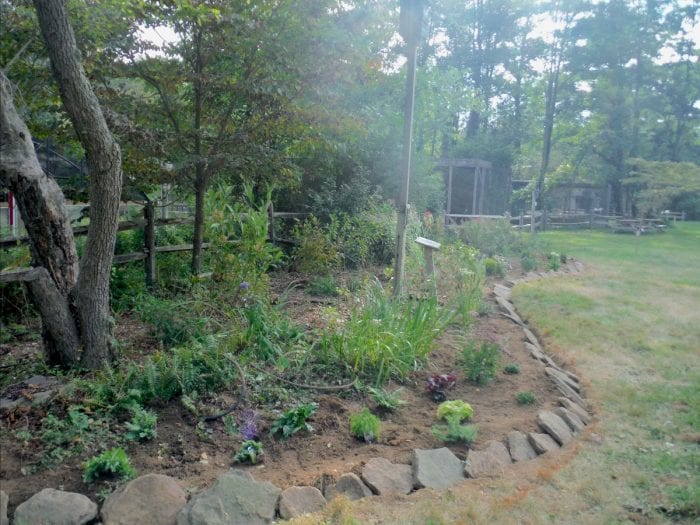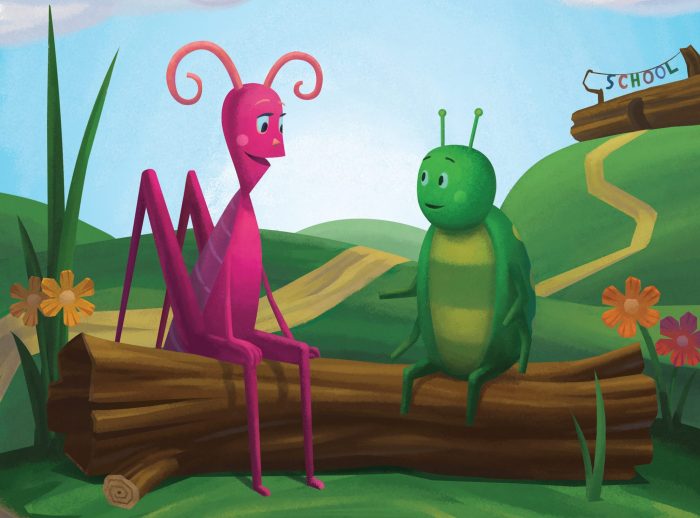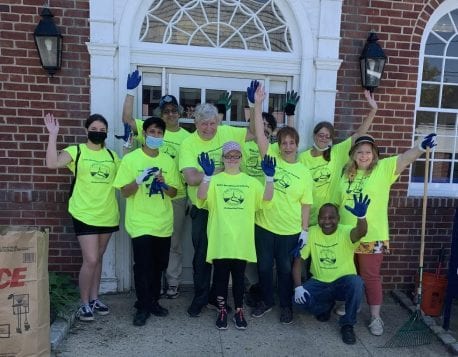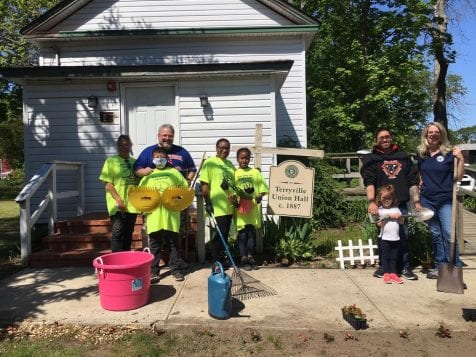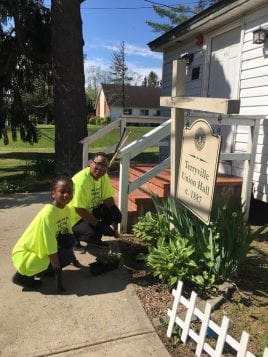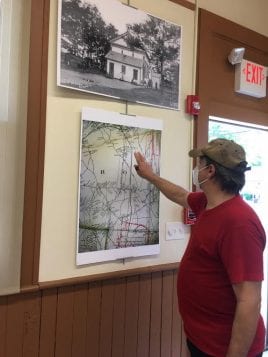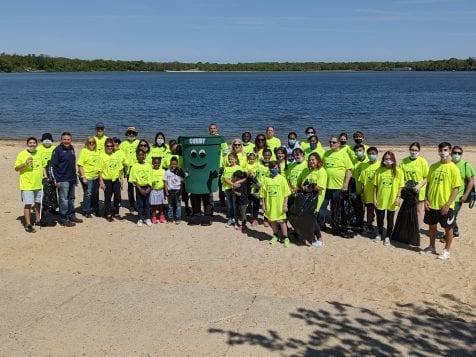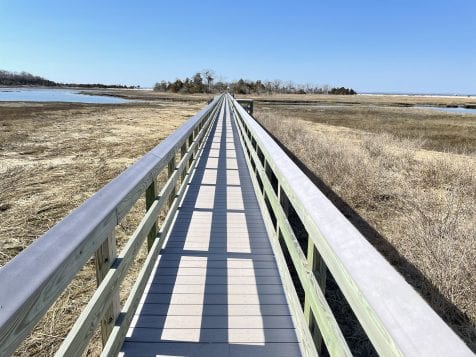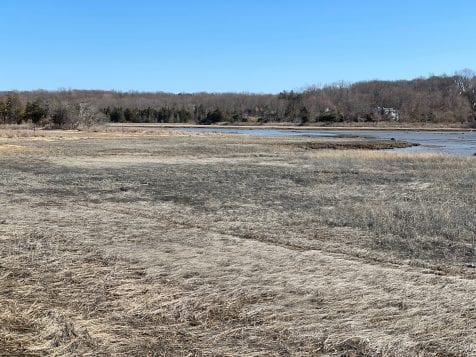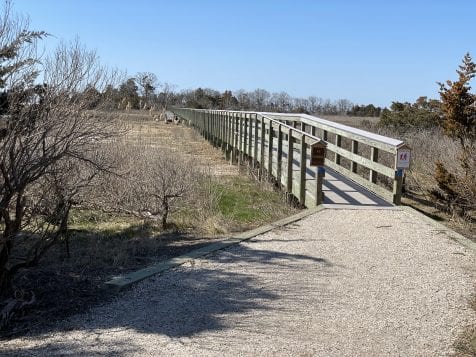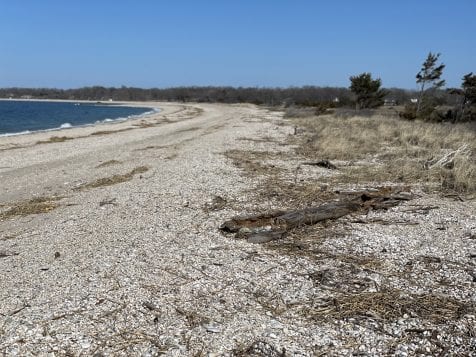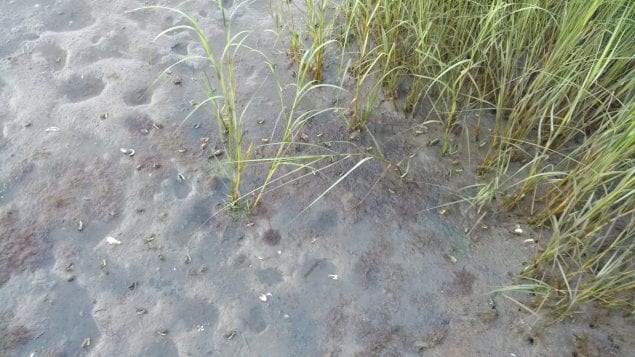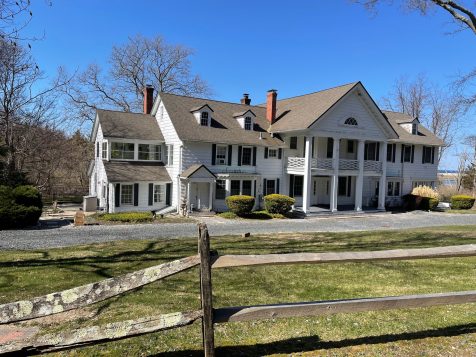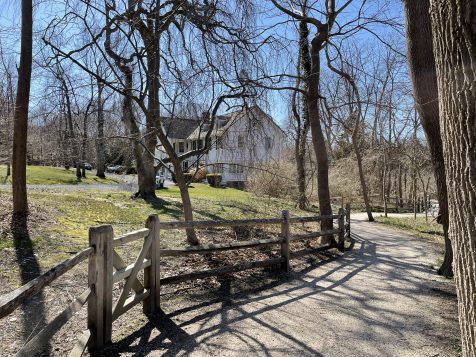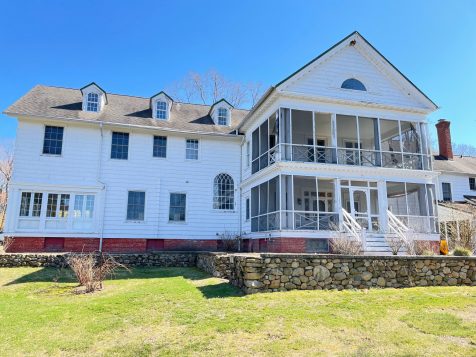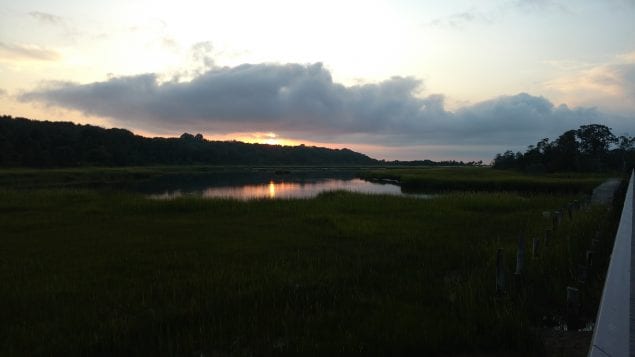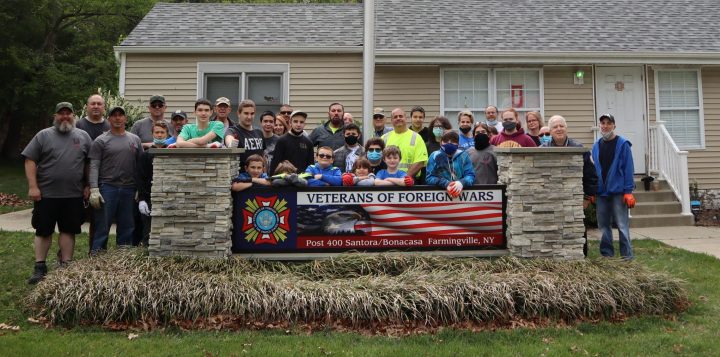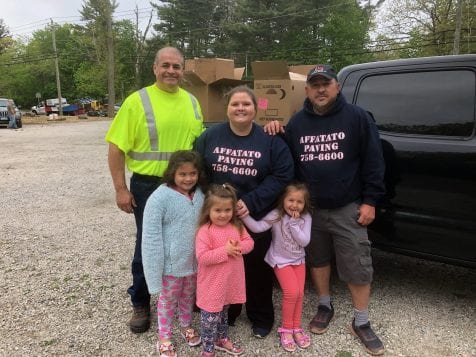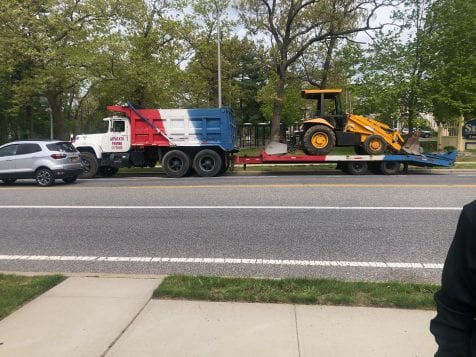Old Field Montessori keeps Brookhaven beautiful
Students, parents and teachers of the Montessori School at Old Field participated in the 13th annual Great Brookhaven Cleanup on May 15. “Everyone agreed that keeping the environment clean is always a worthy cause,” said Ditas Alcala, the school’s director. Photo from Old Field Montessori
Collaborative effort harvests bags of sugar kelp in Setauket Harbor
Members from the Town of Brookhaven, the Setauket Harbor Task Force and other environmental groups headed out on two boats last week to harvest a potentially new aquatic crop — sugar kelp.
On Thursday, May 20, after a several-months-long process of preparing, planting and harvesting, volunteers joined Brookhaven bay constables out of Port Jefferson Harbor to head slightly west in retrieving the brown native seaweed that was brought to two labs for study.
The project was spearheaded by nonprofit The Moore Family Charitable Foundation — a community involvement group that helps with projects throughout Long Island and the five boroughs.
“Our main goal for this year is to spread the word about kelp and where it grows, the conditions it needs, how to process it and how it can benefit growers on Long Island,” Wendy Moore, benefactor and manager of the sugar kelp project, previously told TBR News Media.
According to the foundation’s lead scientist David Berg, sugar kelp is known to be edible for both people and pets, it can be used as a fertilizer, bioplastic, biofuel, cosmetics and is a method to help improve water quality.
Collaborating with the Town of Brookhaven, the Setauket Harbor Task Force, the School of Marine and Atmospheric Sciences at Stony Brook University and Cornell Cooperative Extension, it took a large group of different people to implement a crop that could become a big deal on Long Island.
Town Supervisor Ed Romaine (R) said that when he became supervisor, he immediately knew he wanted to lease out the town’s bays and harbors for projects like this.
“Not only clams and oysters, but also for things like kelp, which is tremendous,” he said. “And seaweed. I think that we can start an industry and stimulate it to become a major industry.”
In December, the task force dropped mooring anchors and set up the kelp growing field’s area in Setauket Harbor. In January, members attached the kelp seedlings to a line just under the surface of the water between buoys there.
George Hoffman, a trustee of the task force which helped oversee the sugar kelp cultivation and production, said partnerships like this are critical to get stuff done.
“We’re really thankful to the partnership,” he said. “Between the town and the harbor group, we wouldn’t be able to do what we’re doing if we didn’t have that partnership. It’s just a great example of how government works with citizens groups.”
Nestled in the water between Port Jefferson and Setauket, more than 200 pounds worth of sugar kelp was retrieved.
Along with being a sustainable crop, sugar kelp helps take in excess nitrogen and CO2 from harbor waters, improving its chemistry. Hoffman said that excess nitrogen causes harmful algae bloom and excess CO2, resulting in ocean acidification.
“Removing nitrogen and CO2 from the waterways is absolutely critical,” Romaine added. “So, [sugar kelp] shows a lot of promise — and if you worry about methane gas, cows eat this when they feed and have 80% less gas.”
Town Councilman Jonathan Kornreich (D-Stony Brook) joined on the boat, lifting up bags of kelp to weigh. He said that projects like this not only help the environment, but can also make positive changes in the private sector in the future.
“To me this is the way that government should operate,” he said. “We make investments like this, into scientific research, or ways to develop either materials, or crops or techniques that can have a positive impact on things.”
Eventually, he said, a private sector can take over and make a business out of the crop.
“Government has a role in helping to get that started and making those investments in science,” he said.
Romaine said that Brookhaven has the largest waterfront of any town on the Island. In Port Jefferson, the area surrounding the harbor where the kelp was harvested goes back to the village’s original roots.
“We’re looking around and asking, ‘What could be the new industry for our town? What could give it life? What could be productive? How could we help nature to save clams, oysters, seaweed, kelp?’” he said. “Those industries are the future that we have to be visionary enough to support and to put the muscle of town government behind it.”
Join the 4HAS for Habitat Garden Maintenance Volunteer Day
The Four Harbors Audubon Society will host a Habitat Garden Maintenance Volunteer Day event at Sweetbriar Nature Center, 62 Eckernkamp Drive, Smithtown on Friday, May 28, from 4:30 p.m. to 6:30 p.m.
Photo of the Week
CALM WATERS
Patricia Conway captured this peaceful scene at Centennial Park in her hometown of Port Jefferson. She writes, ‘It was a gorgeous morning in Port Jeff! Just had to share!
Send your Photo of the Week to [email protected]
Sweetbriar Nature Center presents Music, Friends and Bugs event
Join Sweetbriar Nature Center, 62 Eckernkamp Drive, Smithtown for music, reading, and meeting lots of critters big and small on May 23 from 3 to 4:30 p.m. Johnny Cuomo will do some storytelling, read his book, Katy Didn’t, and sing some tunes. Then enjoy some animal programs featuring some 6 and 8 legged friends as well as some other ambassador animals that live at the center. Best for ages 3 to 8. $10 per child. To register, visit www.sweetbriarnc.org.
Scenes from The Great Brookhaven Clean Up – May 15, 2021
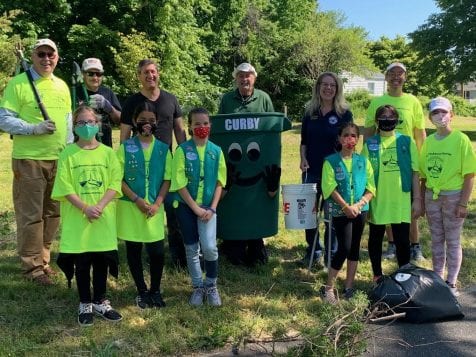
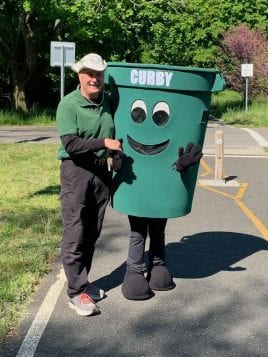
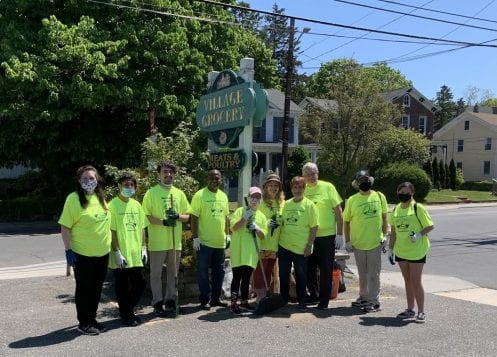
Community members came out for the 2021 Great Brookhaven Clean Up on May 15. Co-sponsored by the Town of Brookhaven’s Department of Recycling and Sustainable Materials Management and Keep America Beautiful, Inc., the event is part of a national effort that draws over 5 million volunteers in more than 20,000 communities across America who come together to pick up litter and clean miles of roadway, rivers, lakes, and more.
Nature Matters: A pond called Flax
By John L. Turner
Scattered along Long Island’s North Shore, in pockets that indent the meandering coastline, are well known places we cherish and enjoy. These harbors and bays like Huntington, Stony Brook, and Mt. Sinai Harbors or Manhasset and Conscience Bays, are places where we fish, kayak, swim, and clam. They are popular places as the number of boats dotting their surface and bathers along their edges can attest. But there is one embayment that has no swimmers, boaters, or clammers — an embayment a bit off the beaten path that has much beauty and is worth exploring — the state-owned Flax Pond in Old Field.
Flax Pond is not a pond now but once was, separated from Long Island Sound by a bermed beach stretching along its northern edge. In the early nineteenth century a section of beach adjacent to the northeastern corner of the pond was scooped away, connecting the Sound’s waters with those of the pond. Flax Pond, so named as it was once a popular place for retting flax, went from being fresh to salt in a matter of days.
You can’t help but notice a building as you pull into the parking lot at Flax Pond. It is the Flax Pond Marine Laboratory operated by the School of Marine and Atmospheric Sciences (SOMAS) at SUNY Stony Brook, in cooperation with the New York State Department of Environmental Conservation which owns the building and the land upon which it sits. SOMAS conducts marine research here on a wide variety of topics including fish and shellfish biology and has a hatchery and algae grow-out center. The lab is used by scientists and graduate students for marine research and is also a destination for students of all ages to learn more about the species and natural communities found in Long Island’s marine environment.
Leaving the parking lot, you’ll pass an informative kiosk that contains an aerial photograph to orient you as well as basic information about the environment at Flax Pond. The easy traversable trail heads west past the Child’s Mansion, where today lectures and seminars are given but where many decades ago Eversley Childs and his family lived. He had bought the house (at that time much smaller and a different style) and several hundred acres which was soon converted into Crane Neck Farm, a working farm, with horse stables, pastures, and gardens. An enormous (by Long Island standards) London Plane tree, a hybrid of our native mottled-bark sycamore tree shades the backyard.
The trail continues through a coastal forest dominated by red cedar, past some artifacts of the outdoor gardens and an orchard that were part of the mansion grounds. Soon the trail forks; stick to the right and in moments will be on a new, elevated boardwalk that traverses the marsh. Shortly, you’ll be greeted with a panoramic view of a salt marsh spilling away on both sides of the boardwalk.
As you near the point where the boardwalk becomes a “bridge,” spanning the tidal creek, look down on both sides in the edge of the marsh mud and if the tide is right (you want to visit at low tide both to see the crabs and to negotiate the trail further north to gain access to the Long Island Sound shoreline) you’ll undoubtedly see many dozens of fiddler crabs. They’ll likely be feeding with both male and female crabs hurriedly stuffing bits of mud into their mouths — the females using both of their arms but the males using only one since the other is an extremely enlarged fiddle that is of no help come dinnertime.
Fiddler crabs are a common and important species in tidal wetland ecology. They recycle plant matter, breaking it down so it may be reincorporated into the salt marsh and are themselves prey items for other species higher up on the food chain like wading birds.
The boardwalk continues, ending on a slightly elevated island. But keep following the highly visible trail markers with the hiking medallions affixed to them as the trail runs along the edge of the coastal forest. Here are the “driftwood skeletons” of many standing but dead red cedar trees, all a silver grey color from years of being burnished in the elements. They are visually stunning.
The trail traverses a low-lying marsh area between the island and the higher ground that separates Flax Pond from Long Island Sound. Please watch for fiddler crabs and their burrows, making sure to not crush any crabs or openings.
If you make it to the beach, you’ll flank a coastal forest dominated by red cedar and post oak. Take a closer look at the oak and you’ll notice its distinctive leaves; thick and leathery, they have rounded lobes telling you they’re a member of the “white oak’ family of oaks and their cross-shape illustrates they are post oaks — no other oak tree species on Long Island has leaves with quite the same outline. The species has an affinity for the coast, and it is along Long Island’s coast, especially the north shore where it is most prevalent.
The wood of the post oak is strong and heavy and is used for making – ready for this? Posts! The wood is also made into railroad ties and tunnel props in mines.
The trail terminates at the shore. In the colder months it’s worth scanning the Sound waters for waterfowl species like scoters, eiders and long-tailed ducks, and for gannets, loons, and horned grebes. In warmer months look for plovers and terns. In all seasons enjoy beachcombing for jingle and slipper shells!
IF YOU GO: To get to Flax Pond take Nicolls Road north to Route 25A in Setauket. Make a left onto Route 25A heading to Stony Brook. Make a right onto Quaker Path Road and veer left onto Mt. Grey Road. Follow Mt. Grey Road past West Meadow Beach Road. Make a left onto Crane Neck Road (look for a stone pillar with a Crane Neck sign on the front). The road winds and passes Holly Lane; shortly after this make a right onto Shore Drive. The Childs Mansion will be on your left; go past it and make a left into the Flax Pond Lab parking lot.
A resident of Setauket, John Turner is conservation chair of the Four Harbors Audubon Society, author of “Exploring the Other Island: A Seasonal Nature Guide to Long Island” and president of Alula Birding & Natural History Tours.
Stony Brook Medicine employees raise awareness about geese crossings
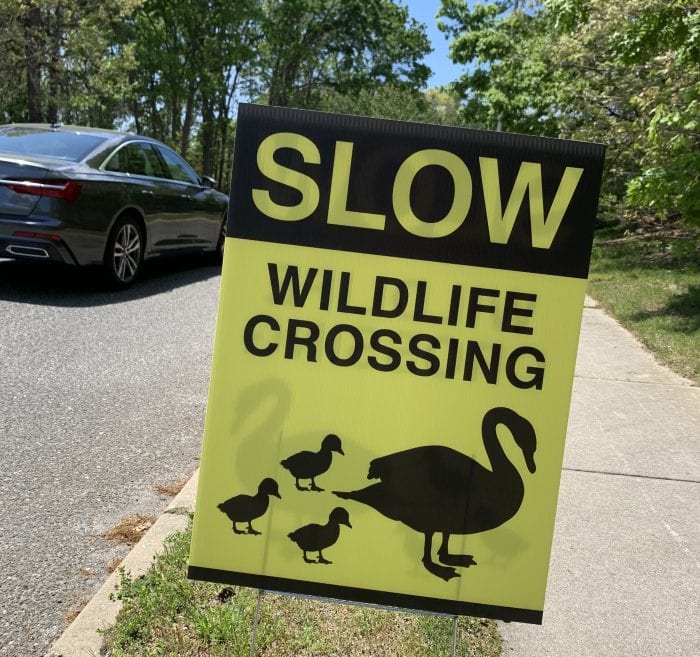
Traveling down Belle Mead Road in the Three Village area drivers will notice wildlife crossing signs sprinkled along the way from the nature preserve to Route 347.
Volunteers installed the signs with the hope that drivers would slow down, especially when seeing wildlife, including geese who at times walk across the road when they have no feathers to fly.
Two years ago, Anita Jo Lago, of Stony Brook, was on her way to work at Stony Brook Medicine and ready to pull into the Tech Park parking lot when she saw a bonded goose pair starting to cross the street. She decided to park her car first before helping the waterfowl cross the road by stopping traffic, something that she had done several times before by her office.
Unfortunately, in the short time it took her to park her car, she said, a vehicle coming down the road, traveling approximately 50 mph on the 30 mph road, killed the first crossing goose.
“He died in my arms at the curb while his mate watched and waited,” she said.
Her co-worker Marianne Bastian saw how upset her colleague was over the incident, and came up with the idea of installing signs along the road. She said she was inspired by a neighbor who was running for local office and asked if people would put signs on their lawns.
Bastian contacted the Town of Brookhaven about installing signs along the roadway, filled out online forms, talked to property owners for approval to place the signs and more.
Lago, who is the wildlife coordinator at Frank Melville Memorial Park, said she doesn’t usually talk about her wildlife efforts at the office.
“I deal with wildlife a lot but I don’t usually talk about it at work, but I told [Bastian] and a light went off with her,” Lago said.
While the town initially put signs up near the Laurel Ridge Setauket Woods Nature Preserve, the women felt more was needed. That’s when they went to their work colleague, Donna Monte, to help with designing signs. Bastian added that colleagues then joined in to help pay for the signs which can cost around $10 each to print.
Bastian said she never did anything like this before.
“I do get very upset when I see a dead animal on the road, it’s just something that … it just breaks my heart,” she said.
Due to their efforts, there are now 20 reminders along the road, and the women are starting their third year during a time when Canadian geese eggs are hatching and goslings are joining their parents. Lago said the goslings started hatching about two or three weeks ago and now are walking around. The geese molt right after the eggs hatch so they can’t fly either. She said there are other animals who have been injured or killed by drivers, and this is the season where you see increased cases.
“Everything is moving about,” she said.
The signs will stay up until the goslings develop feathers and are able to fly.
Lago said Bastian, who travels from Sayville to work, checks the signs on the southside of the road, and she checks from the northside. Even with working from home during the pandemic, Lago said she would go out at night or on the weekends to check the signs. Or if Bastian saw an injured goose, she would call Lago who would come and see what could be done or call someone to help.
Both said while placing the reminders, many pedestrians have thanked them, and some drivers have even shouted gratitude out their car windows as they pass by.
Lago said she hopes the town might consider speed bumps, flashing lights or more police officers in the future. With the road recently being repaved, she said speeding has increased.
“I think it’s the mentality of being in a rush and going, going, going,” she added.
Cleanup held at VFW Post 400 in Farmingville
Last week Suffolk County Legislator Nick Caracappa coordinated a yard cleanup at the Santora/Bonacasa VFW Post 400 in Farmingville. In addition to Caracappa and Post members, assistance was provided by Affatato Paving, Boy Scouts from Troop #124, Cub Scouts from Pack# 124 and other community members.
The cleanup effort was organized as a result of illegal dumping of concrete and debris that occurred on Post #400’s grounds. “I was astonished to learn that an individual or business would dishonor our veterans by selfishly littering on the post’s grounds,” stated Legislator Caracappa.
“I knew they needed help, and was pleased with the response and outpouring of support I received from Affatato Paving, the Boy Scouts/Cub Scouts from Troop 124 in Holbrook, and many others. As we honor our veterans during the month of May, which is National Military Appreciation Month, I thank all volunteers for a job well done.”


